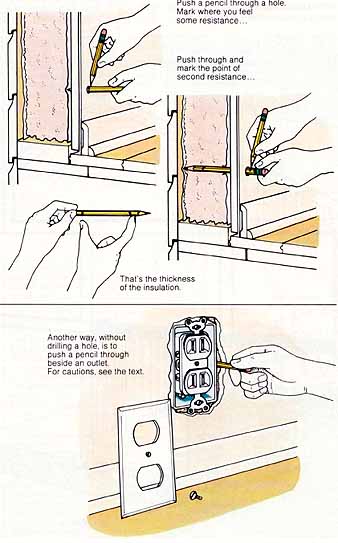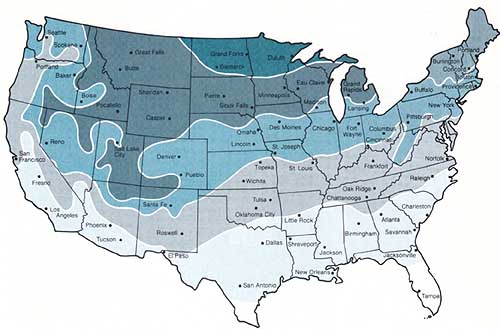The next question, then, is how much insulation do you need? and the answer—like so many answers about energy conservation—is: That depends.
Like the general field of energy development, energy conservation is relatively new as a major set of government and consumer programs. Everyone investigating, studying, or writing on the subject has some powerful opinions about the potency of the insulation you should have.
How much is enough for you depends on both personal and general factors.
The personal factors include: what temperature makes you comfortable; how long you plan to live in your house; the age and construction of your house; the number of people who live in your house; and how much time those people spend indoors, and at what activities.
The more general factors include the climate in your part of the world, and the climate on your block—which may be quite different from the climate just around the corner. Some energy reports have urged people living around Detroit, Michigan, for instance, to insulate their attics to R-30 and even as high as R-33. Others have found that the point of diminishing returns is reached at R-19— that is, further insulation does help, but it is more expensive to install than the energy it will save.
After the first few inches of insulation (for example, a blanket or batt), additional insulation may be far less cost-effective. In most parts of the Midwest, for example, it will take about ten years to gain sufficient energy savings to equal the expense of adding ceiling insulation from R-11 to R-19. However, when you upgrade your insulation from nothing (about A-3 in most houses) to R-19, it will almost certainly pay you back in about five years. For a savings-estimate formula, see previous section.

How Much Insulation Do You Have? (above) Push a pencil through
a hole. Mark where you feel some resistance...Push through and mark the
point of second resistance... That’s the thickness of the insulation. (below)
Another way, without drilling a hole, is to push a pencil through beside
an outlet. For cautions, see the product text.
• How much do you have? When you did the audit, you discovered how much and what kind of insulation you already have in different parts of your house—ceilings, floors, and walls. For a closer, more specific look, here are a few easy ways to test your insulation almost any place indoors.
If the wall, floor, or ceiling in question is covered, you could pry off a small piece of the covering. However, if it looks like prying off a piece might be damaging or messy, drill a small hole through it, in some dark corner. Then insert a pencil, length of dowel, or other thin, straight object until you feel resistance. That is where the insulation begins. Mark your stick at that point, and push it through the insulation until you reach the next point of resistance, which will be either the vapor barrier or the far wall. Mark your stick again. The distance between the two marks is the thickness of your existing insulation. If you can hook a bit of it on the end of your stick, you can find out what kind of insulation it is, as well.
Another way to identify your insulation is to go through an electric socket. Turn off your electricity first, or your discovery could prove to be a rude shock.
Lighting your way by flashlight, remove the light switch or socket cover and look around the in-wall installation. If you see a vapor barrier, you almost surely have blankets or batts. If you find insulation but no vapor barrier, you probably have fill or foam-in-place. Try to hook a wisp of it with a wire coat hanger, for identification purposes. If you don’t recognize it by the illustrations shown earlier, show it to the salesperson at your hardware store or building supply out let. Loose fill may have settled; if so, in winter the wall will be appreciably cooler toward the ceiling than toward the floor.
You can also go through the TV antenna, the cable TV outlet, and dead wall-plates covering possible future socket holes. This will keep you from having to deal with live electric outlets.
When you know how much of what kind of insulation you have in which parts of your house, you can determine what additional insulation you want to install. In adding your insulation, make certain you do not cover those vents that will keep your attic ventilated (see Ventilation section).
As we’ve indicated, how much insulation you actually need depends on your immediate climate—your location with regard to sun, wind, large trees, and so on. We’ll discuss the nature and use of specific climates at greater length in our chapter about the basics of solar energy. For now, the map and charts on this page will provide you with some general guidelines.
• Estimating how much insulation to buy: Before you start, you should know not only how deep you want your insulation to be, but also how many square feet of space it must cover. Make this calculation by multiplying the length of your attic floor by its width. For an aver age” uninsulated attic of 1400 square feet, you should allow about a day or so to accomplish the work, once you’ve got your materials on hand.
Recommended R-values:
Heating Zone |
Attic Floors |
Ceilings Over Unheated Crawlspace or Basement |
Exterior Walls |
1 2 3 4 5 |
R-26 R-26 R-30 R-33 R-38 |
R-11 R-13 R-19 R-22 R-22 |
R-value of full wall insulation, which is 3½” thick, will depend on material used. Range is R-11 to R-13. |
Inch Equivalents of Various Insulations for Different R-values:
Insulation |
R-11 |
R-19 |
R-22 |
A-3D |
R-38 |
Fiberglass batts/blankets Urethane foam-in-place Rock wool batts/blankets Fiberglass loose fill Rock wool loose fill Cellulose loose fill |
4” 2” 3” 5” 4” 3” |
6” 3” 5.5” 8.5” 6.5” 5” |
6.5” 3+” 6” 10” 7.5” 6” |
10” 4.5” 9” 13.5” 10.5” 8” |
12.5” 6” 10.5” 17.5” 13.5” 10.5” |

Next: How to Insulate
Prev: Where to Insulate
